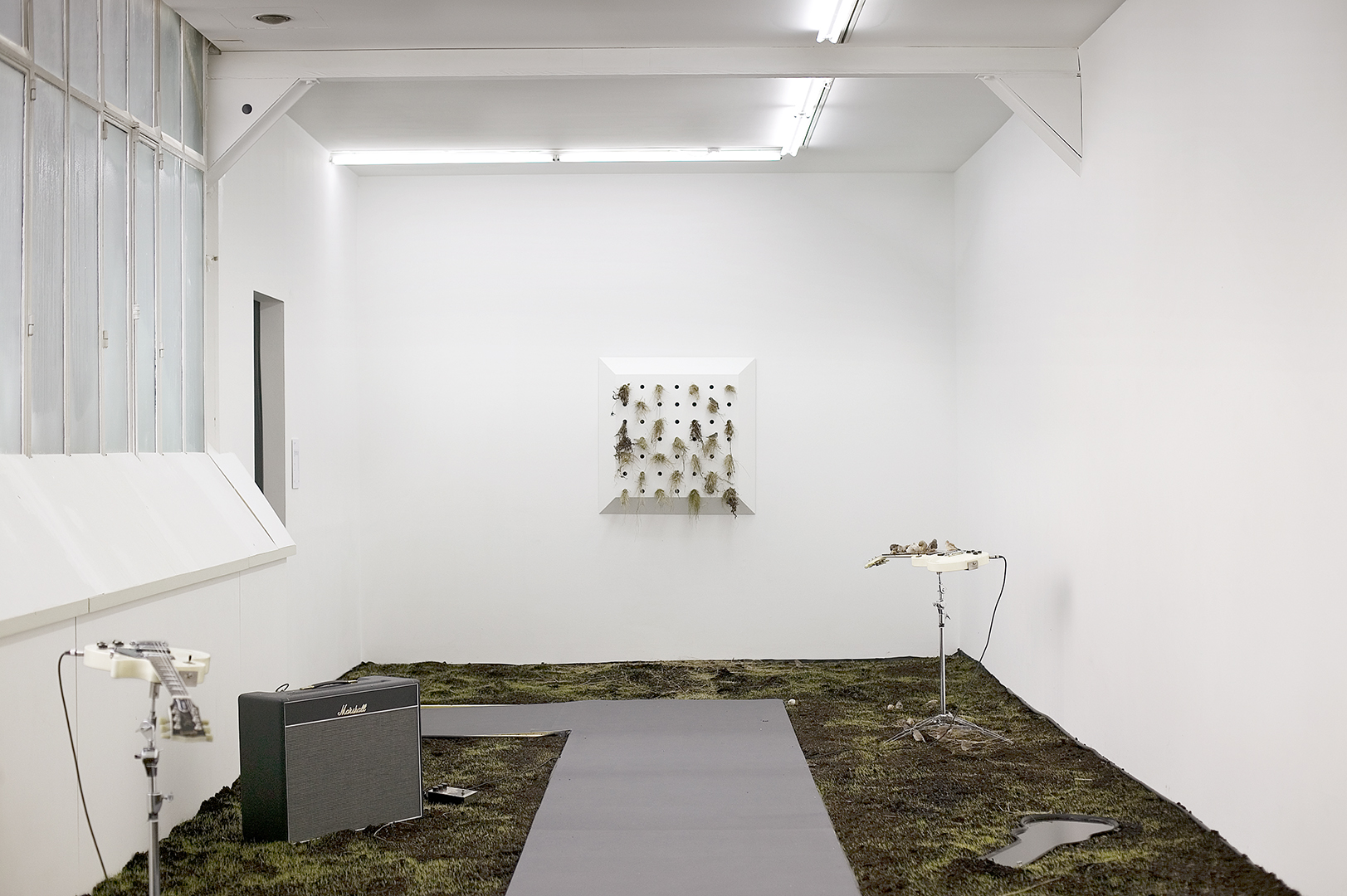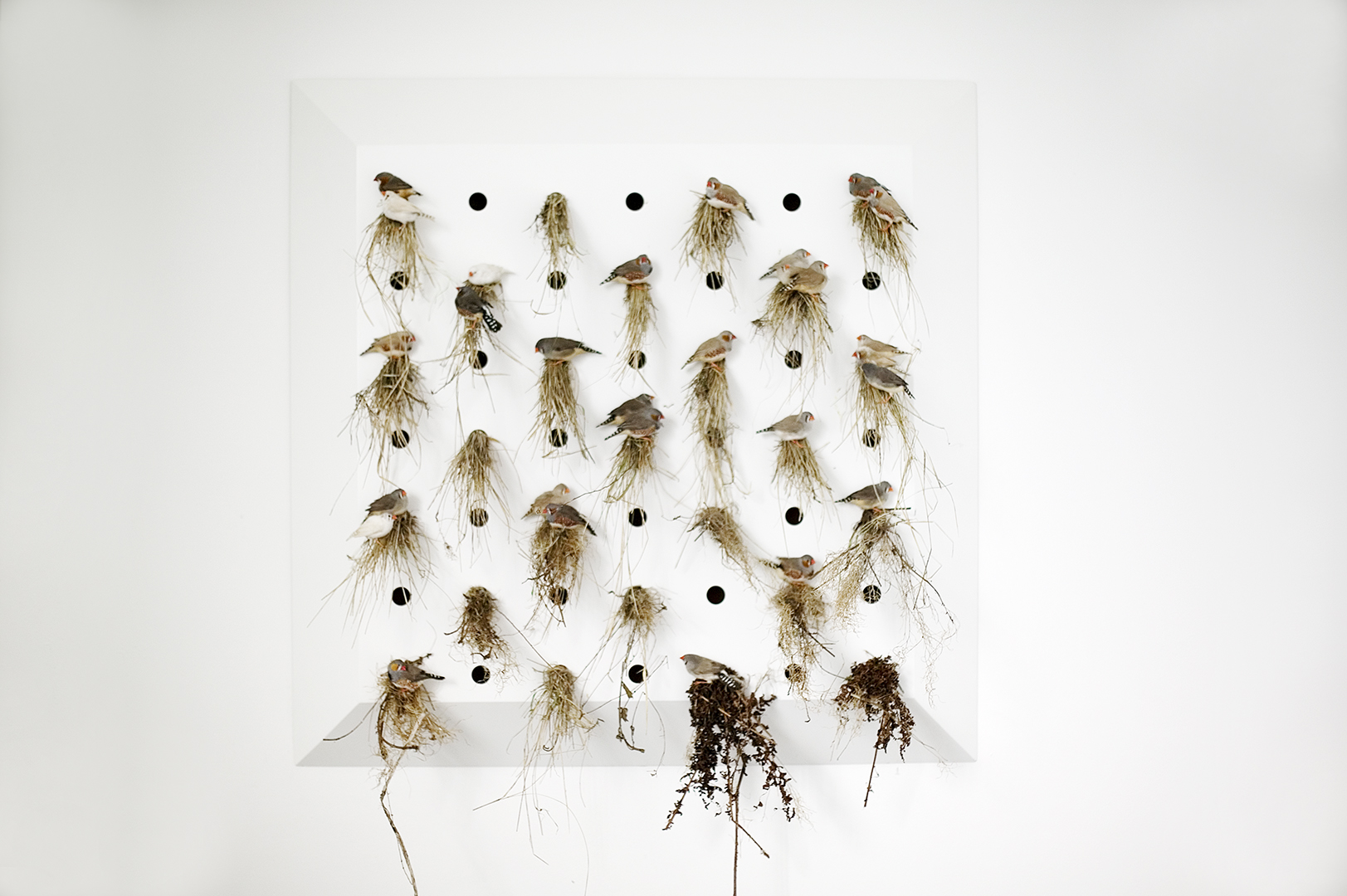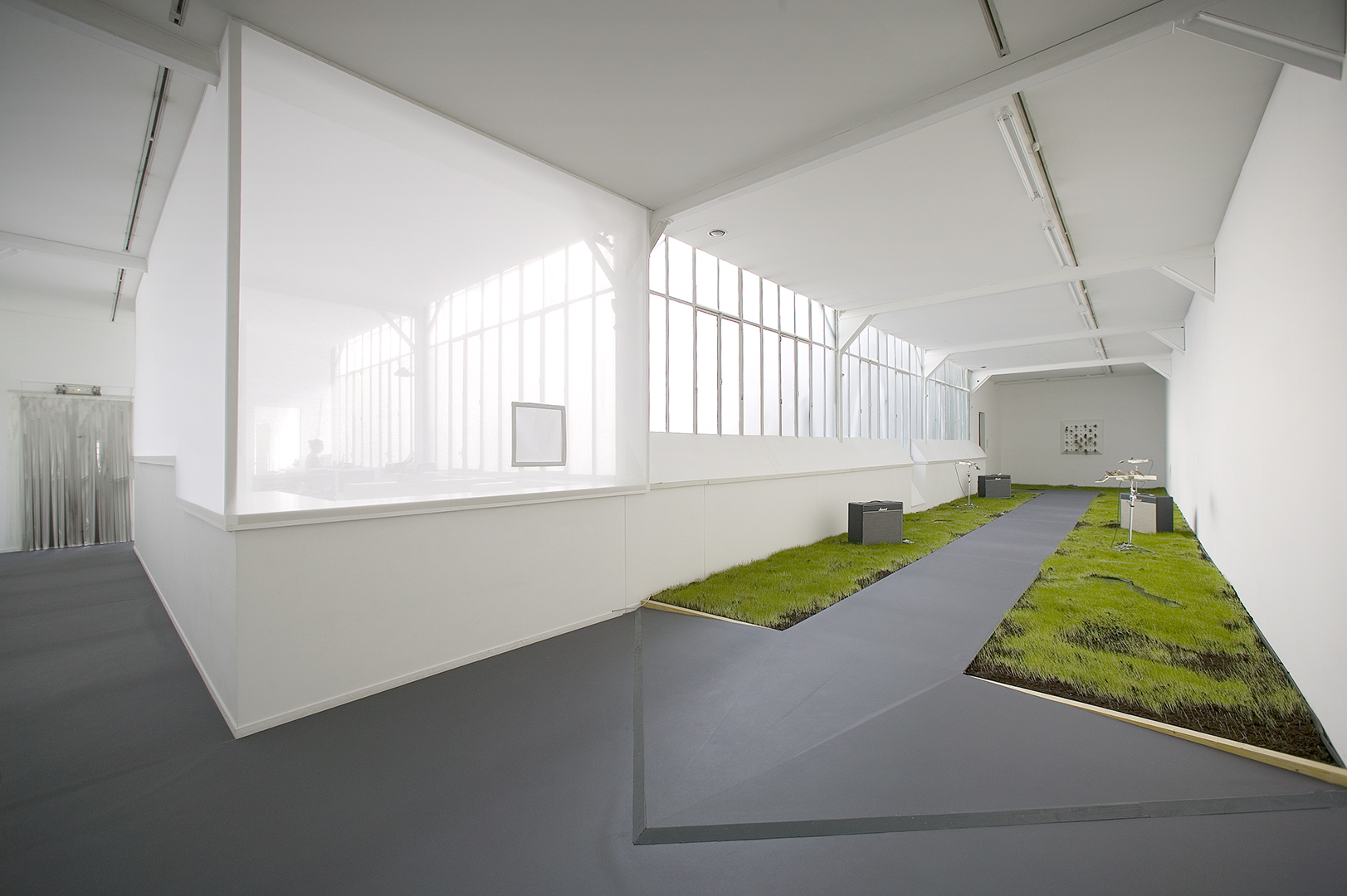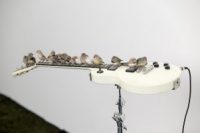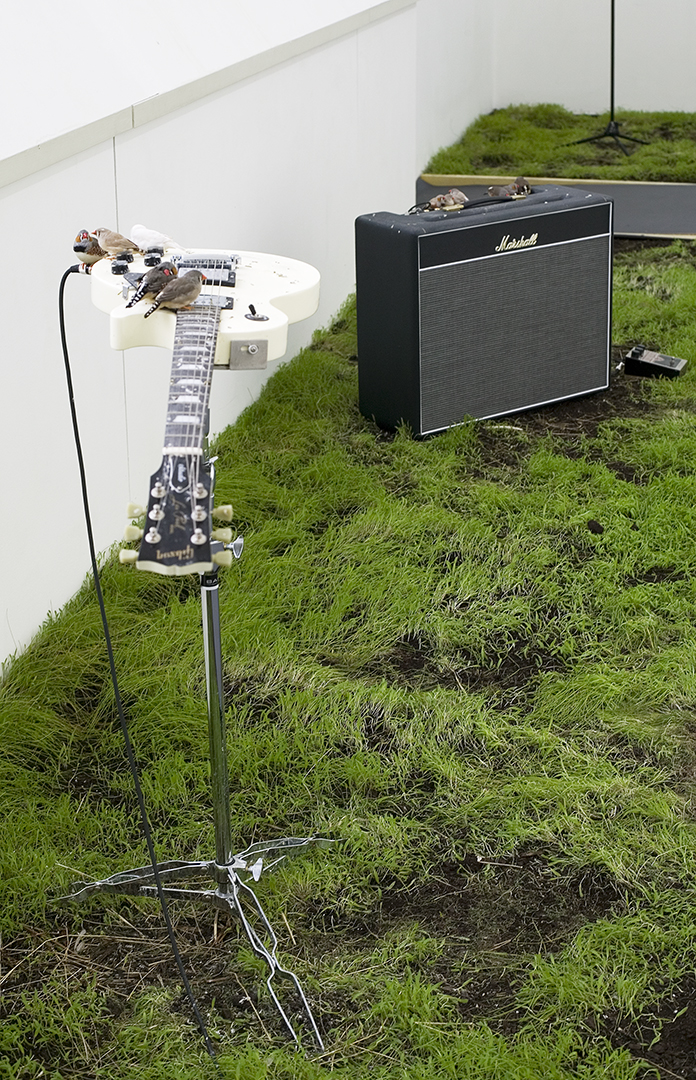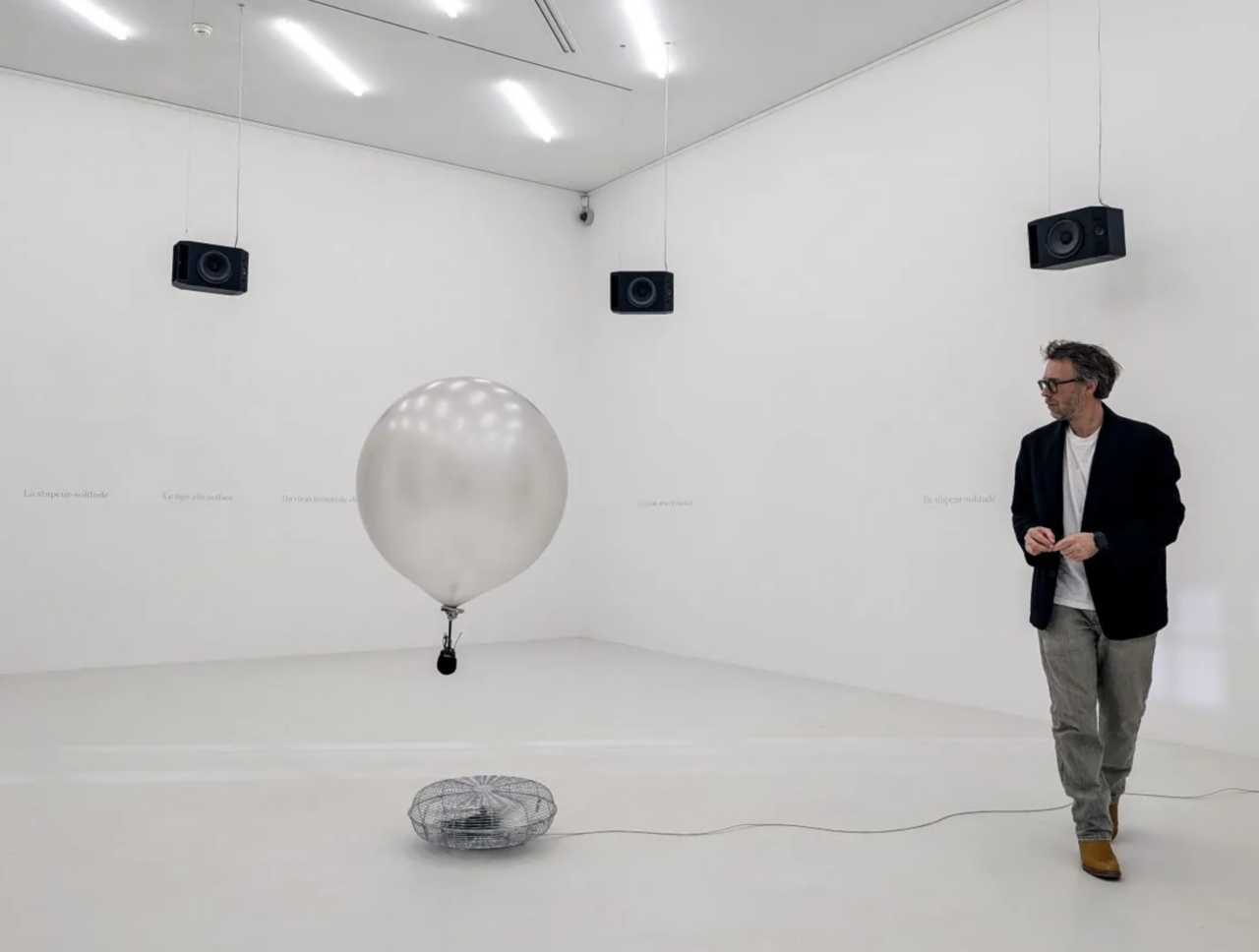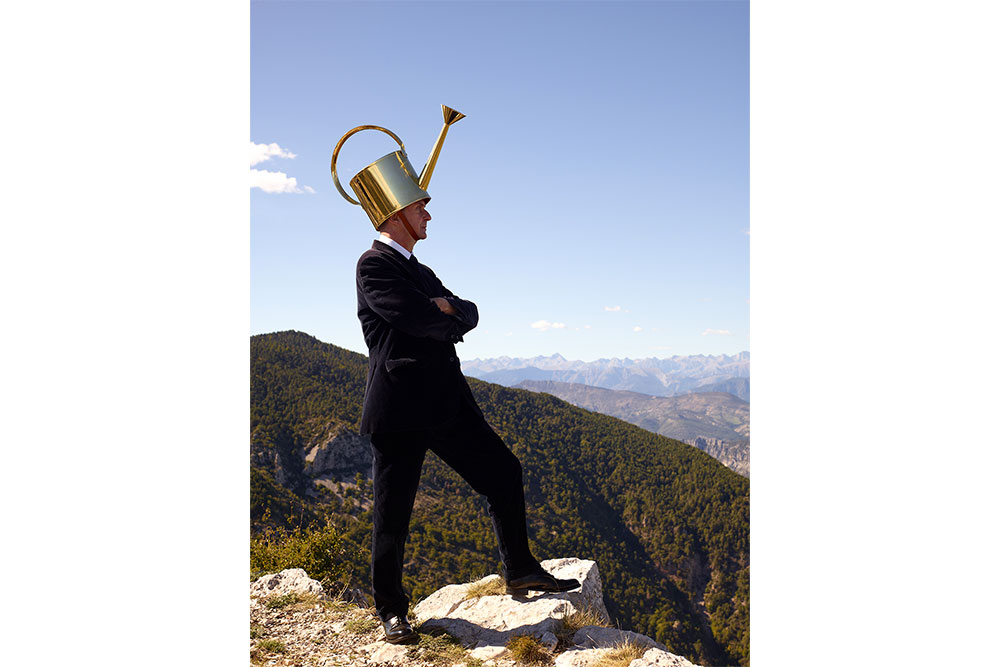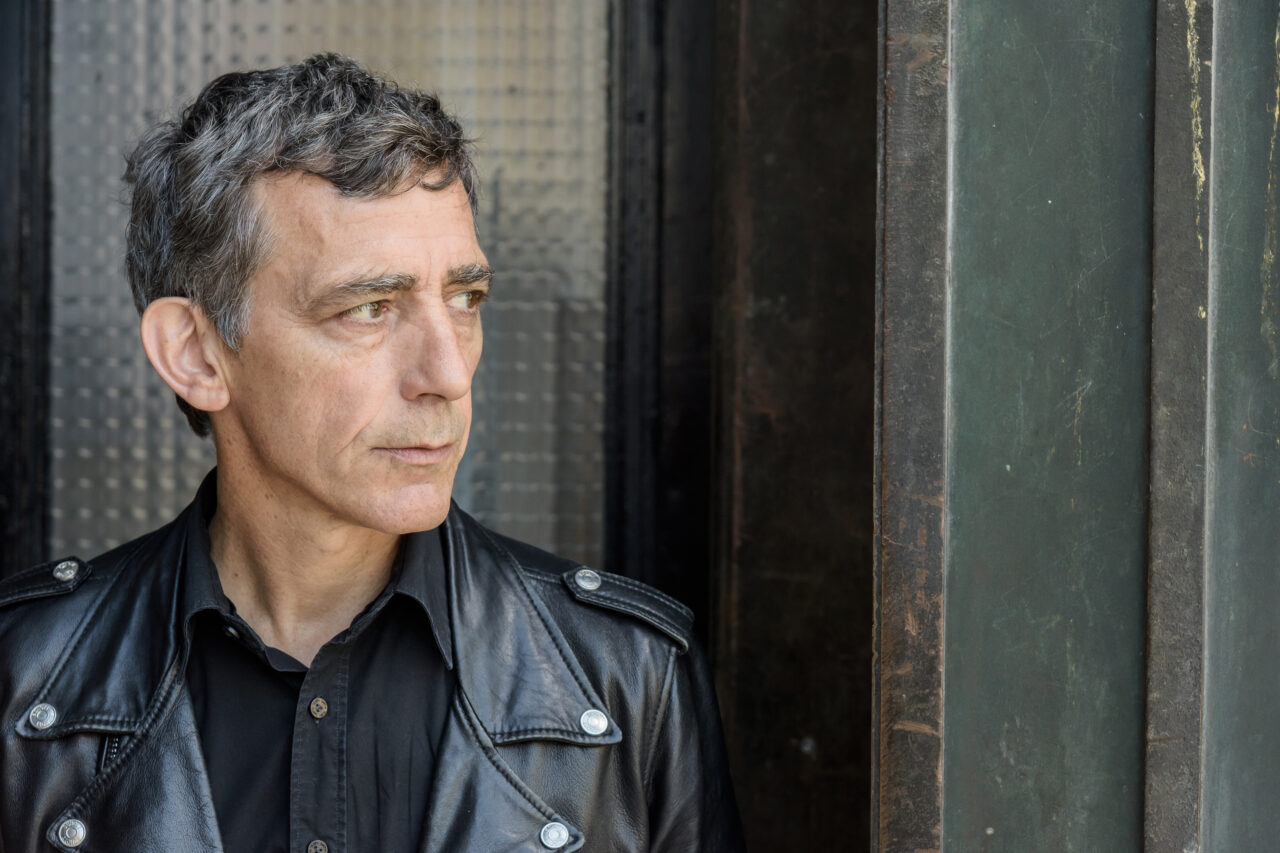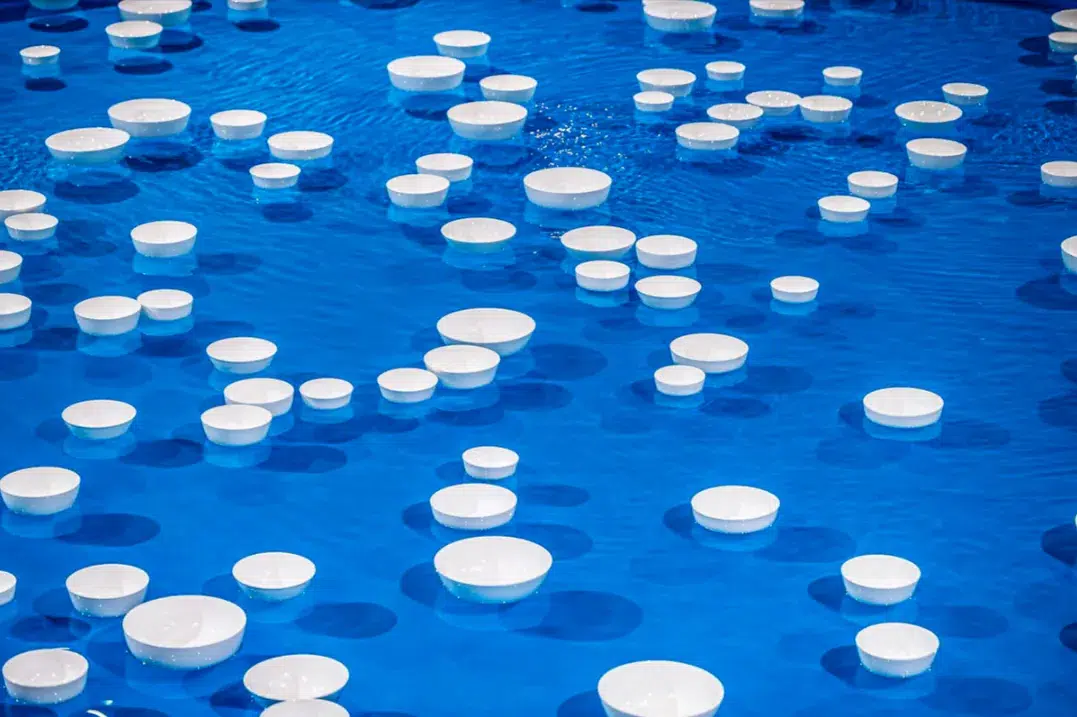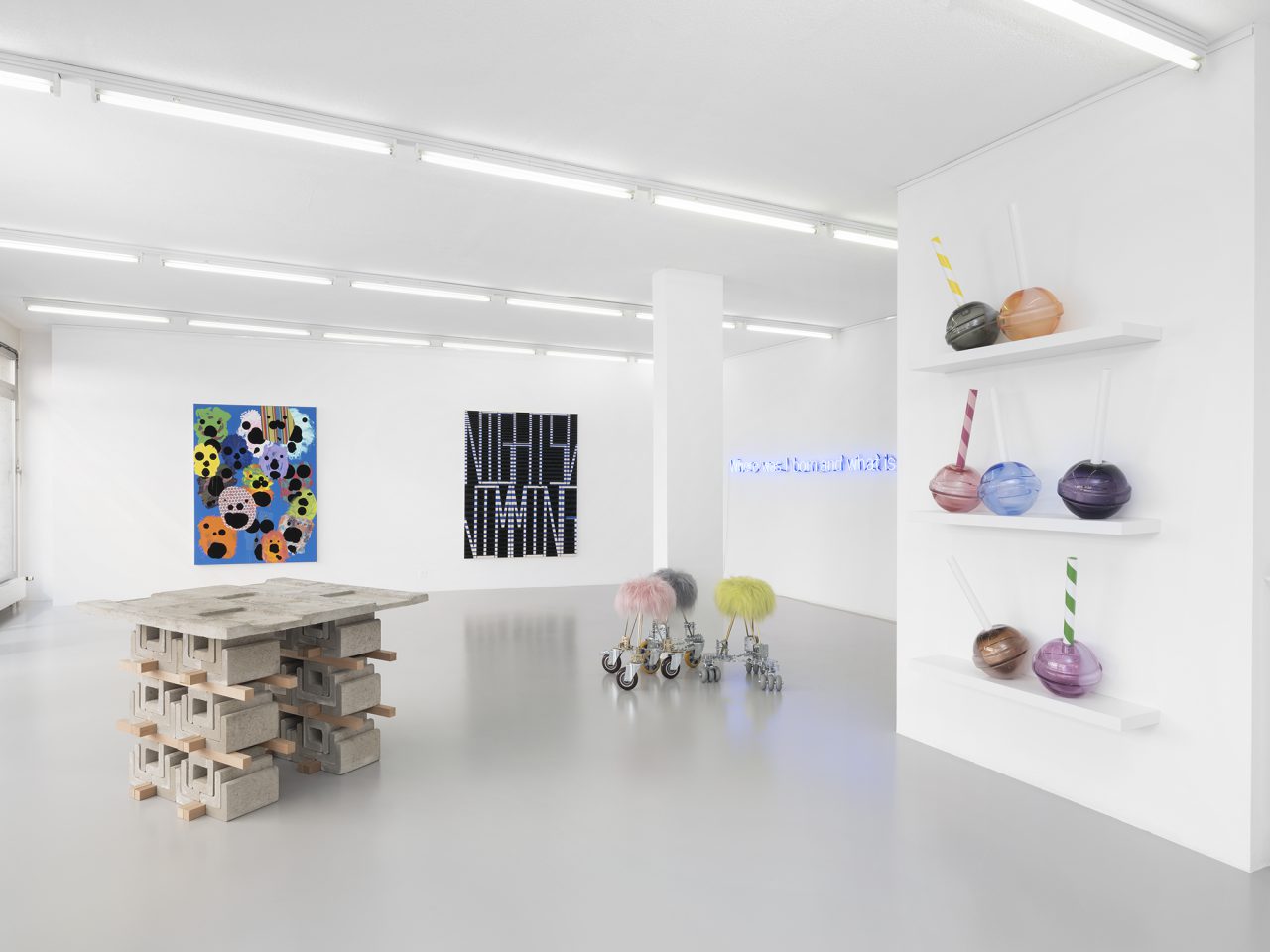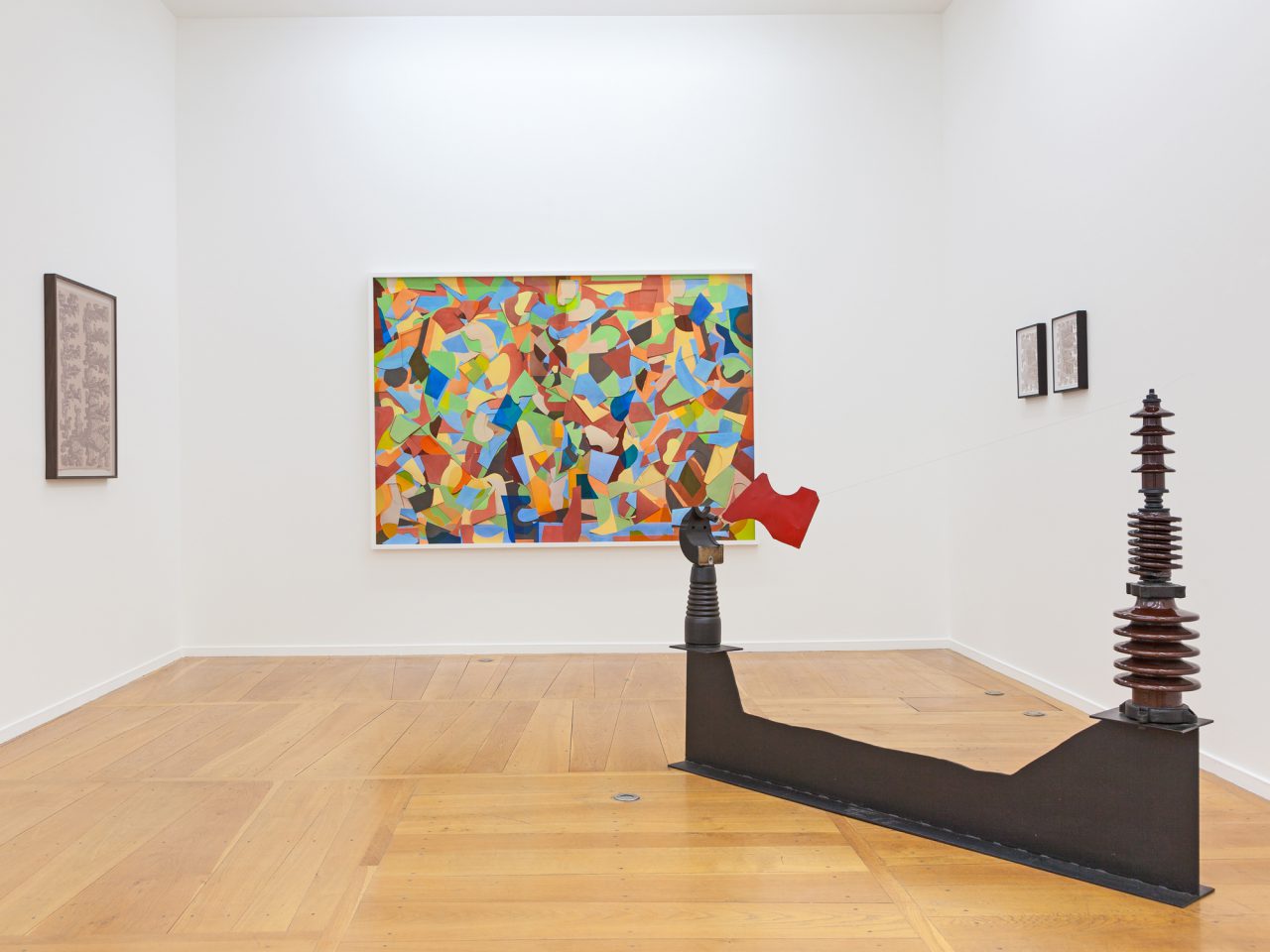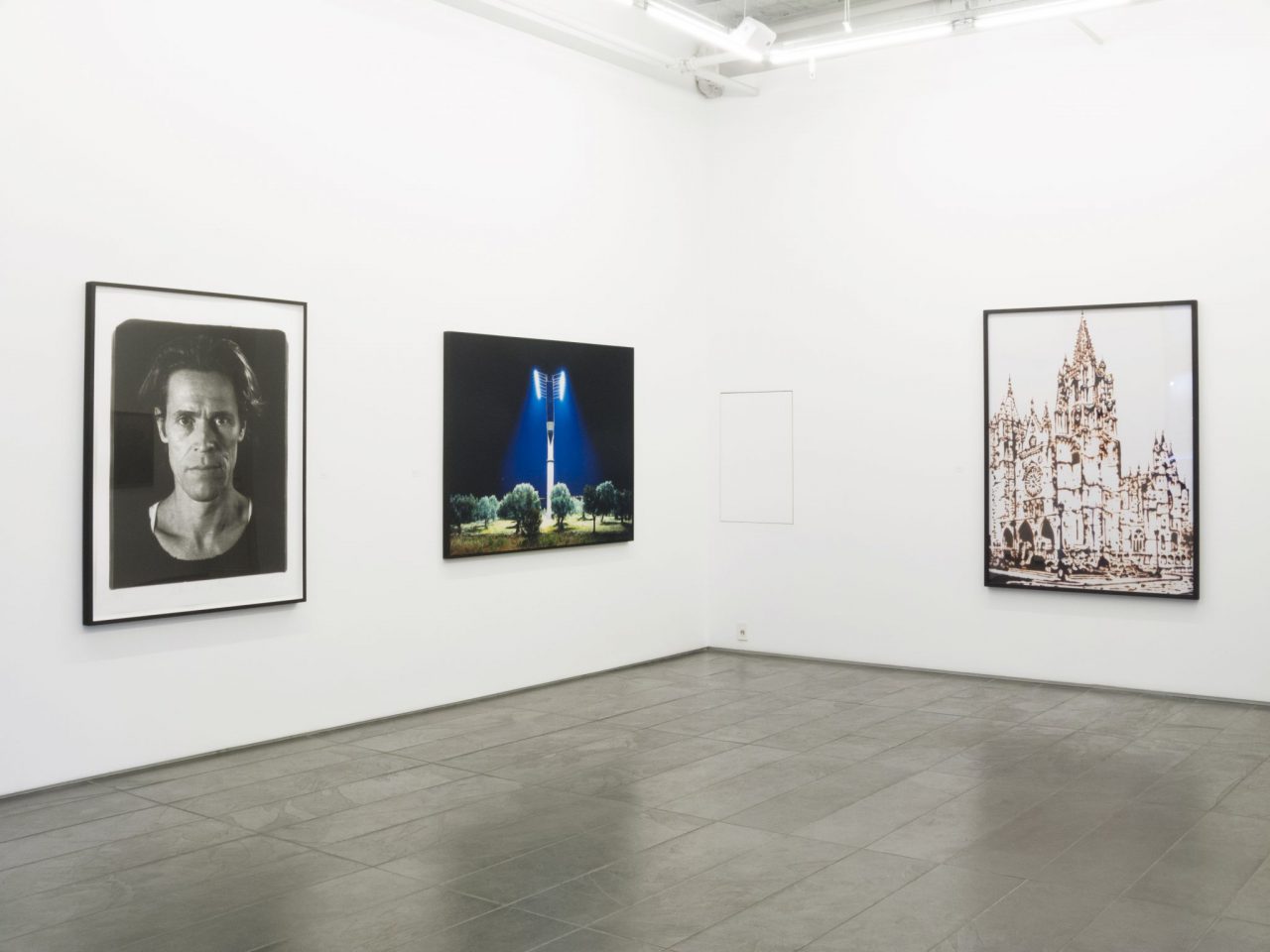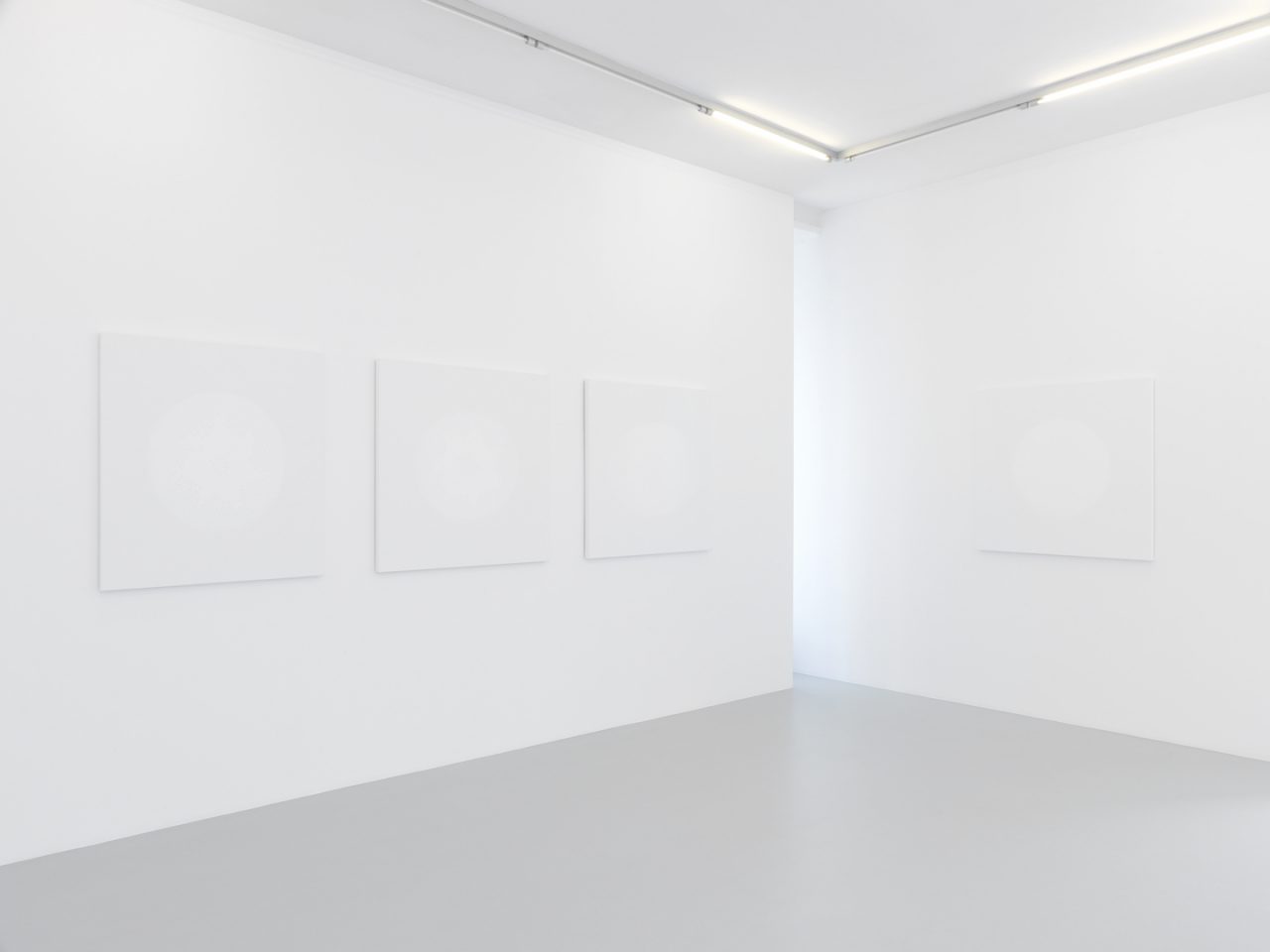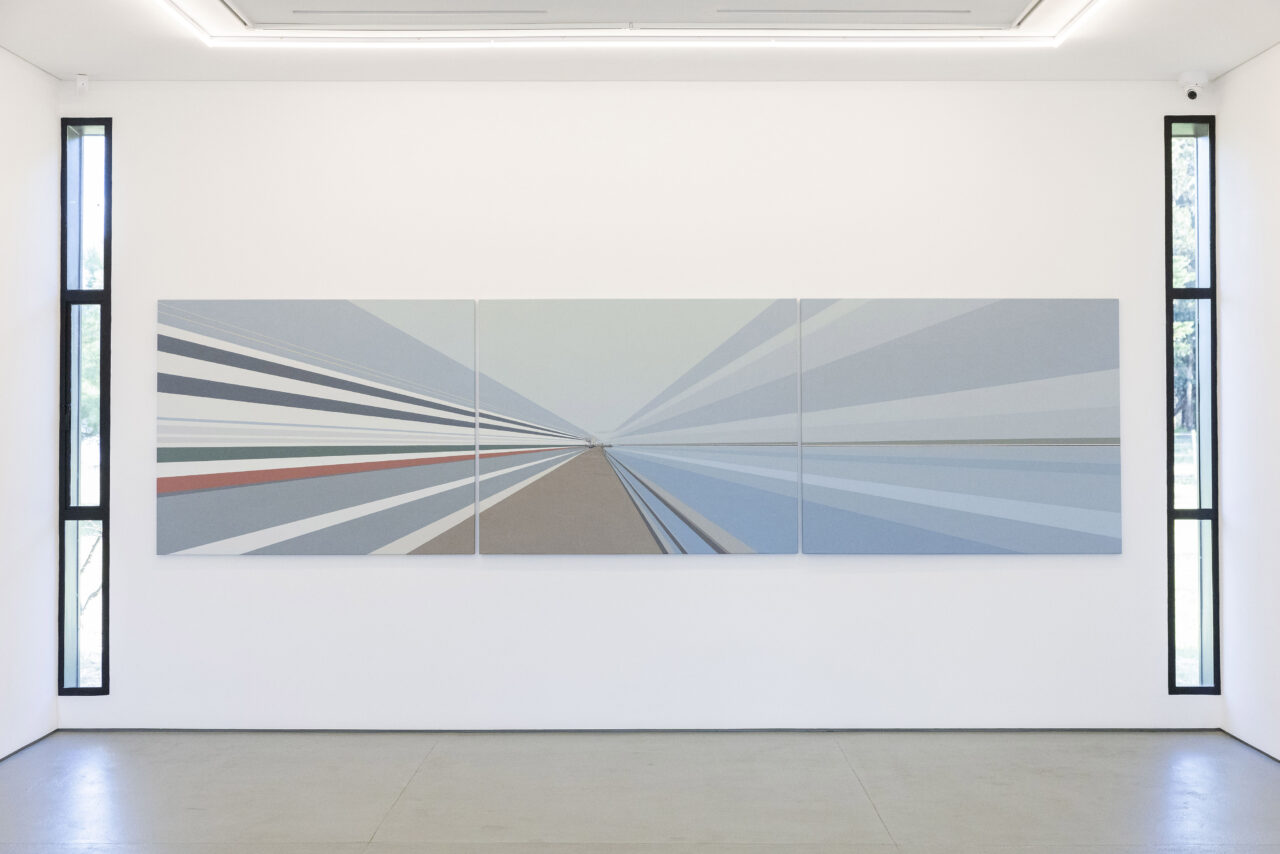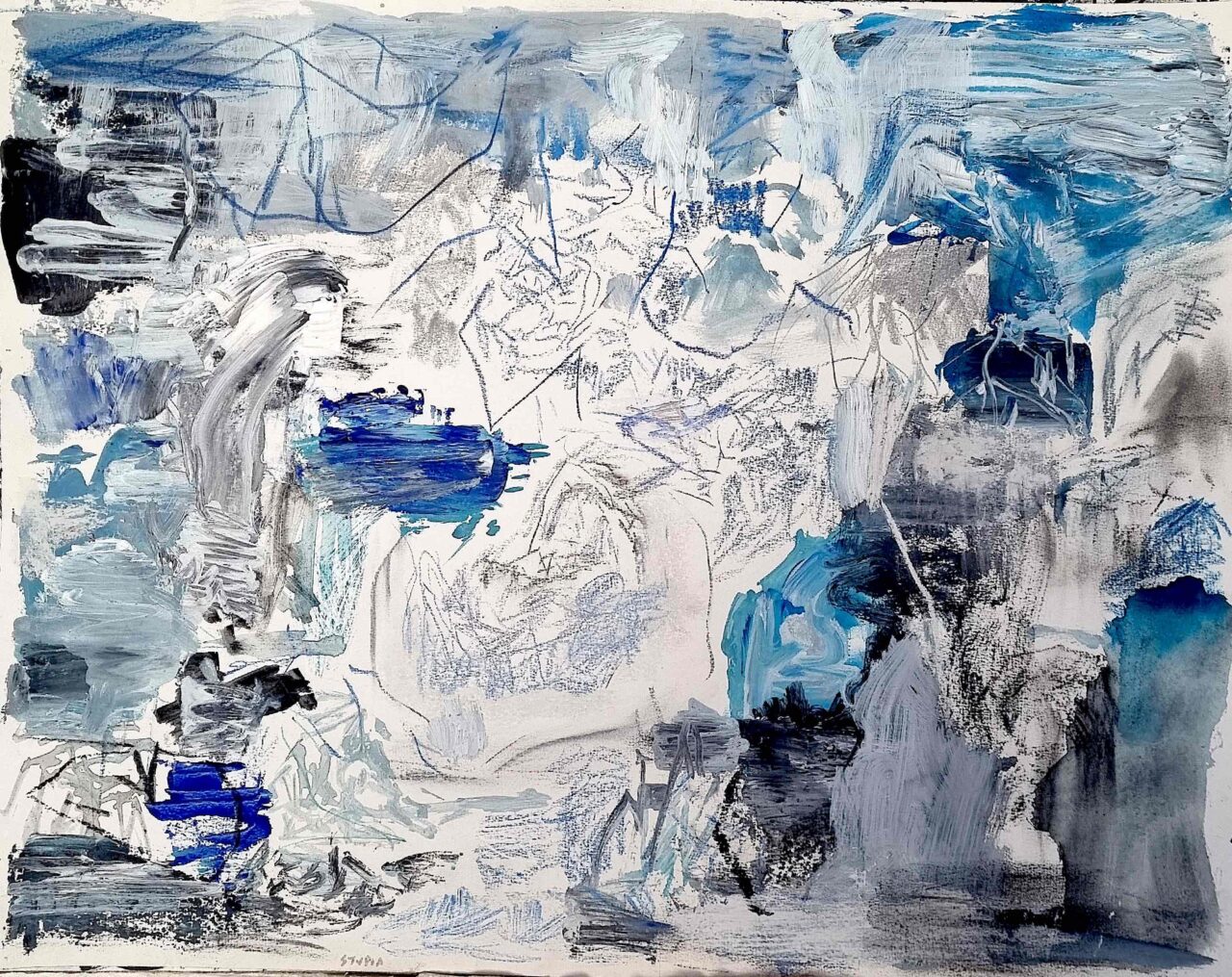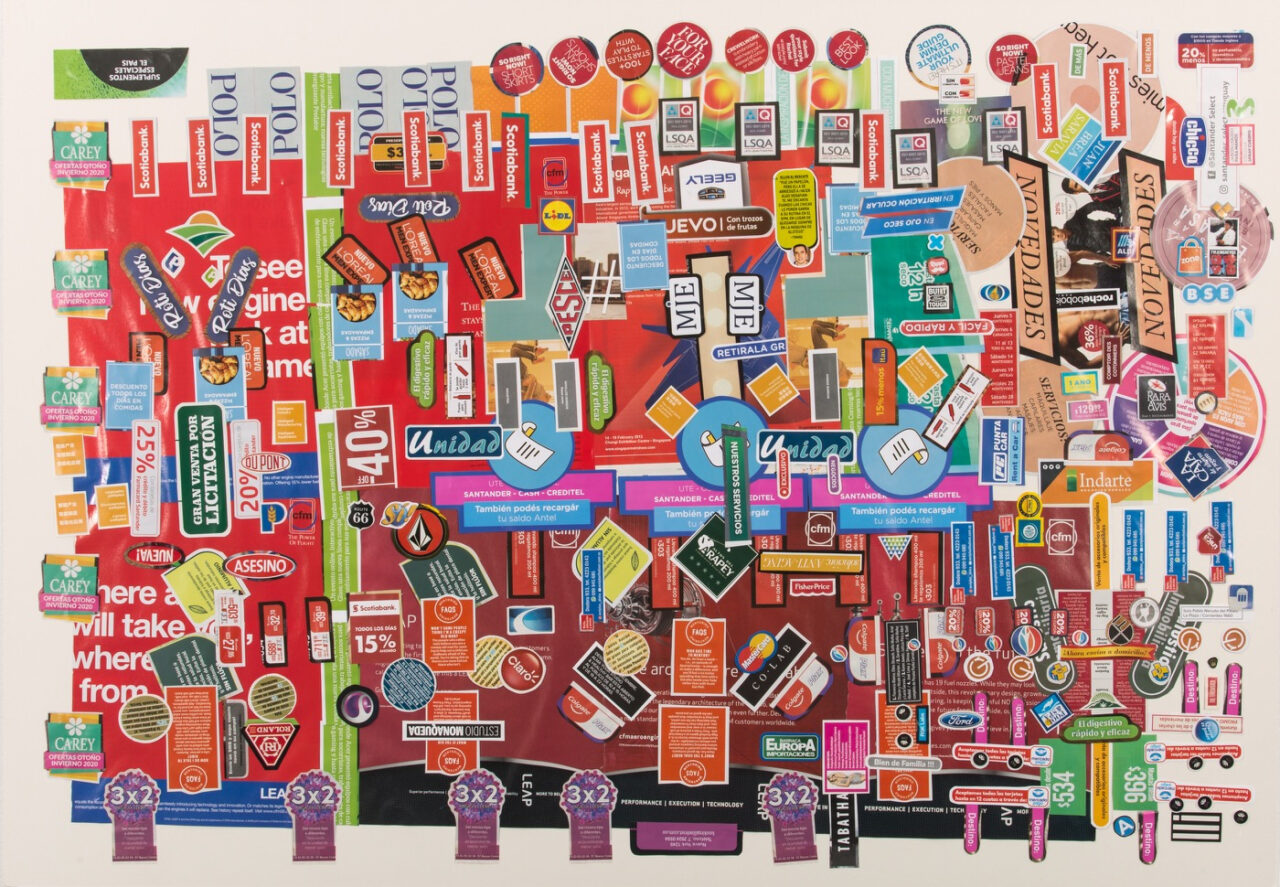Céleste Boursier-Mougenot – From Here to Ear Recycle Zombiedrones
Céleste Boursier-Mougenot
From Here to Ear Recycle Zombiedrones
05.04.08 → 17.05.08
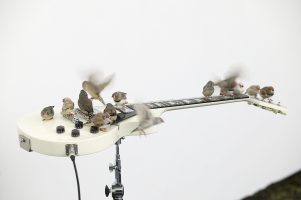
For his first exhibit at Xippas Gallery, the artist Céleste Boursier-Mougenot transforms the gallery into an aviary.
Céleste Boursier-Mougenot started as a musician. From 1985 to 1994, he was the composer for the Pascal Rambert Theatre Company. In the early 1990s, he decided to make his music independent by creating installations in places dedicated to contemporary art. By extracting the “musical potential” of various situations and objects, he creates installations where sound and movement merge and that are meant to be using the entire exhibition space, depending on its location, its architecture and its environment. For the artist, these mechanisms and “their installations” are the necessary conditions for the emergence of works of art that live in the present and evolve through their surroundings.
By giving equal importance to music as a “listening form” and to the modalities of its production and presentation, Céleste Boursier-Mougenot invites us to be listeners who also see, who explore the modalities of permanence and present and to be, as he calls it, “distracted listeners”. Noises in our daily environment or residual noises that are not made for a musical purpose are rich in a potential that Céleste Boursier-Mougenot’s installations transform into a “listening experience” that brings the visible and the audible together and where “the one who contemplates” becomes, temporarily, a full part of the work of art.
The sound of a car driving by, of a chair that’s being dragged, the familiar hum of appliances or the clinking of porcelain bowls floating in a kids’ pool: those are all the fleeting data and materials used by Céleste Boursier-Mougenot to conceive the installations that accompany the physiological rhythm of our life and that extend the expectations of “environment music”. Céleste Boursier-Mougenot uses the flaws of his systems and technical incidents like audio or video feedbacks; he plays on the mismatching of sources with virtuosity: video signals are treated like sounds, he connects harmonicas to vacuum cleaners or uses electric guitars as bird tables… Since 2006, with works like bruitformé, flamByframe, virus or recycle, he has been transposing the principles of feedback and transduction – which founded his vision – to the fields of sculpture, object or image.
For this first exhibit at Xippas Gallery, Céleste Boursier-Mougenot puts together from here to ear that has recently been shown at the Lentos Kunstmuseum of Linz in Austria. This installation, whose principle was conceived in the early 1990s, transforms the gallery into an aviary where visitors share the space with a few dozen birds, who, by landing on electric guitars, create a musical piece.
In another area of the gallery, the artist sets up his “standard set for two TV viewers” from his new work called zombiedrones. Live encrypting of TV images, that are the base for the installation, brings an “eerie strangeness” to everyday scenes emptied of their message.
The exhibit at Xippas Gallery goes along états seconds, the first book about Céleste Boursier-Mougenot’s work to be published. The book, which was conceived by the artist and published by Analogues, a contemporary art publishing house, in collaboration with the Champagne-Ardenne College/Frac, the Lorraine Frac and the Grand Café of St Nazaire, contains an interview of Christophe Kihm by François Quintin, a text by Peter Szendy and an interview of Céleste Boursier-Mougenot by the artist Samuel Bianchini.
Moreover, scanner, a work purchased by the FNAC in 2006, is partaken of the “Nouvelles du Mont Analogue” exhibit at the Museum of Contemporary Art of Rochechouart, started March 1st and for the opening exhibit of the Children’s Museum/Museo de los Niños of San Diego (United States) next May, Céleste Boursier-Mougenot will put together a new installation of harmonichaos, a work for thirteen vacuum cleaners and as many harmonicas.
Lastly, the Theatre of Gennevilliers invites the artist for a new session of the index project; a system made of a Disklavier grand acoustic piano and of hooked up computers will be on work throughout the 2008-2009 season.For his first exhibit at Xippas Gallery, the artist Céleste Boursier-Mougenot transforms the gallery into an aviary.
Céleste Boursier-Mougenot started as a musician. From 1985 to 1994, he was the composer for the Pascal Rambert Theatre Company. In the early 1990s, he decided to make his music independent by creating installations in places dedicated to contemporary art. By extracting the “musical potential” of various situations and objects, he creates installations where sound and movement merge and that are meant to be using the entire exhibition space, depending on its location, its architecture and its environment. For the artist, these mechanisms and “their installations” are the necessary conditions for the emergence of works of art that live in the present and evolve through their surroundings.
By giving equal importance to music as a “listening form” and to the modalities of its production and presentation, Céleste Boursier-Mougenot invites us to be listeners who also see, who explore the modalities of permanence and present and to be, as he calls it, “distracted listeners”. Noises in our daily environment or residual noises that are not made for a musical purpose are rich in a potential that Céleste Boursier-Mougenot’s installations transform into a “listening experience” that brings the visible and the audible together and where “the one who contemplates” becomes, temporarily, a full part of the work of art.
The sound of a car driving by, of a chair that’s being dragged, the familiar hum of appliances or the clinking of porcelain bowls floating in a kids’ pool: those are all the fleeting data and materials used by Céleste Boursier-Mougenot to conceive the installations that accompany the physiological rhythm of our life and that extend the expectations of “environment music”. Céleste Boursier-Mougenot uses the flaws of his systems and technical incidents like audio or video feedbacks; he plays on the mismatching of sources with virtuosity: video signals are treated like sounds, he connects harmonicas to vacuum cleaners or uses electric guitars as bird tables… Since 2006, with works like bruitformé, flamByframe, virus or recycle, he has been transposing the principles of feedback and transduction – which founded his vision – to the fields of sculpture, object or image.
For this first exhibit at Xippas Gallery, Céleste Boursier-Mougenot puts together from here to ear that has recently been shown at the Lentos Kunstmuseum of Linz in Austria. This installation, whose principle was conceived in the early 1990s, transforms the gallery into an aviary where visitors share the space with a few dozen birds, who, by landing on electric guitars, create a musical piece.
In another area of the gallery, the artist sets up his “standard set for two TV viewers” from his new work called zombiedrones. Live encrypting of TV images, that are the base for the installation, brings an “eerie strangeness” to everyday scenes emptied of their message.
The exhibit at Xippas Gallery goes along états seconds, the first book about Céleste Boursier-Mougenot’s work to be published. The book, which was conceived by the artist and published by Analogues, a contemporary art publishing house, in collaboration with the Champagne-Ardenne College/Frac, the Lorraine Frac and the Grand Café of St Nazaire, contains an interview of Christophe Kihm by François Quintin, a text by Peter Szendy and an interview of Céleste Boursier-Mougenot by the artist Samuel Bianchini.
Moreover, scanner, a work purchased by the FNAC in 2006, is partaken of the “Nouvelles du Mont Analogue” exhibit at the Museum of Contemporary Art of Rochechouart, started March 1st and for the opening exhibit of the Children’s Museum/Museo de los Niños of San Diego (United States) next May, Céleste Boursier-Mougenot will put together a new installation of harmonichaos, a work for thirteen vacuum cleaners and as many harmonicas.
Lastly, the Theatre of Gennevilliers invites the artist for a new session of the index project; a system made of a Disklavier grand acoustic piano and of hooked up computers will be on work throughout the 2008-2009 season.For his first exhibit at Xippas Gallery, the artist Céleste Boursier-Mougenot transforms the gallery into an aviary.
Céleste Boursier-Mougenot started as a musician. From 1985 to 1994, he was the composer for the Pascal Rambert Theatre Company. In the early 1990s, he decided to make his music independent by creating installations in places dedicated to contemporary art. By extracting the “musical potential” of various situations and objects, he creates installations where sound and movement merge and that are meant to be using the entire exhibition space, depending on its location, its architecture and its environment. For the artist, these mechanisms and “their installations” are the necessary conditions for the emergence of works of art that live in the present and evolve through their surroundings.
By giving equal importance to music as a “listening form” and to the modalities of its production and presentation, Céleste Boursier-Mougenot invites us to be listeners who also see, who explore the modalities of permanence and present and to be, as he calls it, “distracted listeners”. Noises in our daily environment or residual noises that are not made for a musical purpose are rich in a potential that Céleste Boursier-Mougenot’s installations transform into a “listening experience” that brings the visible and the audible together and where “the one who contemplates” becomes, temporarily, a full part of the work of art.
The sound of a car driving by, of a chair that’s being dragged, the familiar hum of appliances or the clinking of porcelain bowls floating in a kids’ pool: those are all the fleeting data and materials used by Céleste Boursier-Mougenot to conceive the installations that accompany the physiological rhythm of our life and that extend the expectations of “environment music”. Céleste Boursier-Mougenot uses the flaws of his systems and technical incidents like audio or video feedbacks; he plays on the mismatching of sources with virtuosity: video signals are treated like sounds, he connects harmonicas to vacuum cleaners or uses electric guitars as bird tables… Since 2006, with works like bruitformé, flamByframe, virus or recycle, he has been transposing the principles of feedback and transduction – which founded his vision – to the fields of sculpture, object or image.
For this first exhibit at Xippas Gallery, Céleste Boursier-Mougenot puts together from here to ear that has recently been shown at the Lentos Kunstmuseum of Linz in Austria. This installation, whose principle was conceived in the early 1990s, transforms the gallery into an aviary where visitors share the space with a few dozen birds, who, by landing on electric guitars, create a musical piece.
In another area of the gallery, the artist sets up his “standard set for two TV viewers” from his new work called zombiedrones. Live encrypting of TV images, that are the base for the installation, brings an “eerie strangeness” to everyday scenes emptied of their message.
The exhibit at Xippas Gallery goes along états seconds, the first book about Céleste Boursier-Mougenot’s work to be published. The book, which was conceived by the artist and published by Analogues, a contemporary art publishing house, in collaboration with the Champagne-Ardenne College/Frac, the Lorraine Frac and the Grand Café of St Nazaire, contains an interview of Christophe Kihm by François Quintin, a text by Peter Szendy and an interview of Céleste Boursier-Mougenot by the artist Samuel Bianchini.
Moreover, scanner, a work purchased by the FNAC in 2006, is partaken of the “Nouvelles du Mont Analogue” exhibit at the Museum of Contemporary Art of Rochechouart, started March 1st and for the opening exhibit of the Children’s Museum/Museo de los Niños of San Diego (United States) next May, Céleste Boursier-Mougenot will put together a new installation of harmonichaos, a work for thirteen vacuum cleaners and as many harmonicas.
Lastly, the Theatre of Gennevilliers invites the artist for a new session of the index project; a system made of a Disklavier grand acoustic piano and of hooked up computers will be on work throughout the 2008-2009 season.For his first exhibit at Xippas Gallery, the artist Céleste Boursier-Mougenot transforms the gallery into an aviary.
Céleste Boursier-Mougenot started as a musician. From 1985 to 1994, he was the composer for the Pascal Rambert Theatre Company. In the early 1990s, he decided to make his music independent by creating installations in places dedicated to contemporary art. By extracting the “musical potential” of various situations and objects, he creates installations where sound and movement merge and that are meant to be using the entire exhibition space, depending on its location, its architecture and its environment. For the artist, these mechanisms and “their installations” are the necessary conditions for the emergence of works of art that live in the present and evolve through their surroundings.
By giving equal importance to music as a “listening form” and to the modalities of its production and presentation, Céleste Boursier-Mougenot invites us to be listeners who also see, who explore the modalities of permanence and present and to be, as he calls it, “distracted listeners”. Noises in our daily environment or residual noises that are not made for a musical purpose are rich in a potential that Céleste Boursier-Mougenot’s installations transform into a “listening experience” that brings the visible and the audible together and where “the one who contemplates” becomes, temporarily, a full part of the work of art.
The sound of a car driving by, of a chair that’s being dragged, the familiar hum of appliances or the clinking of porcelain bowls floating in a kids’ pool: those are all the fleeting data and materials used by Céleste Boursier-Mougenot to conceive the installations that accompany the physiological rhythm of our life and that extend the expectations of “environment music”. Céleste Boursier-Mougenot uses the flaws of his systems and technical incidents like audio or video feedbacks; he plays on the mismatching of sources with virtuosity: video signals are treated like sounds, he connects harmonicas to vacuum cleaners or uses electric guitars as bird tables… Since 2006, with works like bruitformé, flamByframe, virus or recycle, he has been transposing the principles of feedback and transduction – which founded his vision – to the fields of sculpture, object or image.
For this first exhibit at Xippas Gallery, Céleste Boursier-Mougenot puts together from here to ear that has recently been shown at the Lentos Kunstmuseum of Linz in Austria. This installation, whose principle was conceived in the early 1990s, transforms the gallery into an aviary where visitors share the space with a few dozen birds, who, by landing on electric guitars, create a musical piece.
In another area of the gallery, the artist sets up his “standard set for two TV viewers” from his new work called zombiedrones. Live encrypting of TV images, that are the base for the installation, brings an “eerie strangeness” to everyday scenes emptied of their message.
The exhibit at Xippas Gallery goes along états seconds, the first book about Céleste Boursier-Mougenot’s work to be published. The book, which was conceived by the artist and published by Analogues, a contemporary art publishing house, in collaboration with the Champagne-Ardenne College/Frac, the Lorraine Frac and the Grand Café of St Nazaire, contains an interview of Christophe Kihm by François Quintin, a text by Peter Szendy and an interview of Céleste Boursier-Mougenot by the artist Samuel Bianchini.
Moreover, scanner, a work purchased by the FNAC in 2006, is partaken of the “Nouvelles du Mont Analogue” exhibit at the Museum of Contemporary Art of Rochechouart, started March 1st and for the opening exhibit of the Children’s Museum/Museo de los Niños of San Diego (United States) next May, Céleste Boursier-Mougenot will put together a new installation of harmonichaos, a work for thirteen vacuum cleaners and as many harmonicas.
Lastly, the Theatre of Gennevilliers invites the artist for a new session of the index project; a system made of a Disklavier grand acoustic piano and of hooked up computers will be on work throughout the 2008-2009 season.
Exhibition views
-
![Céleste Boursier-Mougenot, "From here to ear Recycle Zombiedrones"]()
-
![Céleste Boursier-Mougenot, "From here to ear Recycle Zombiedrones", Paris, 2008]()
[:en]Céleste Boursier-Mougenot, View of the exhibition "From here to ear Recycle Zombiedrones", Paris, 2008[:fr]Céleste Boursier-Mougenot, Vue de l'exposition "From here to ear Recycle Zombiedrones", Paris, 2008[:es]Céleste Boursier-Mougenot, "From here to ear Recycle Zombiedrones", Paris, 2008[:]
-
![Céleste Boursier-Mougenot, "From here to ear Recycle Zombiedrones", Paris, 2008]()
[:en]Céleste Boursier-Mougenot, View of the exhibition "From here to ear Recycle Zombiedrones", Paris, 2008[:fr]Céleste Boursier-Mougenot, Vue de l'exposition "From here to ear Recycle Zombiedrones", Paris, 2008[:es]Céleste Boursier-Mougenot, "From here to ear Recycle Zombiedrones", Paris, 2008[:]
-
![Céleste Boursier-Mougenot, "From here to ear Recycle Zombiedrones", Paris, 2008]()
[:en]Céleste Boursier-Mougenot, View of the exhibition "From here to ear Recycle Zombiedrones", Paris, 2008[:fr]Céleste Boursier-Mougenot, Vue de l'exposition "From here to ear Recycle Zombiedrones", Paris, 2008[:es]Céleste Boursier-Mougenot, "From here to ear Recycle Zombiedrones", Paris, 2008[:]
-
![Céleste Boursier-Mougenot, "From here to ear Recycle Zombiedrones", Paris, 2008]()
-
![Céleste Boursier-Mougenot, "From here to ear Recycle Zombiedrones", Paris, 2008]()
[:en]Céleste Boursier-Mougenot, View of the exhibition "From here to ear Recycle Zombiedrones", Paris, 2008[:fr]Céleste Boursier-Mougenot, Vue de l'exposition "From here to ear Recycle Zombiedrones", Paris, 2008[:es]Céleste Boursier-Mougenot, "From here to ear Recycle Zombiedrones", Paris, 2008[:]
